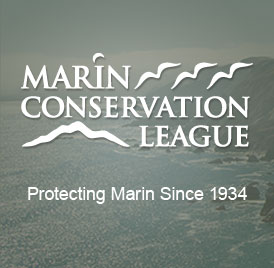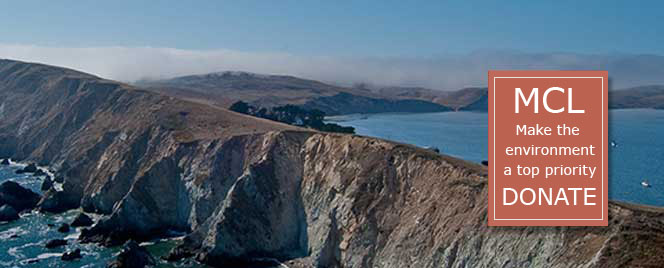| Marin Conservation League | 175 N. Redwood Dr., Ste. 135 | San Rafael CA 94903 | Tel 415.485.6257 | Fax 415.485.6259 Email Us. |
 |
About MCL
MCL Policy re: Siting of Solar Photo-Voltaic Facilities, 9/17/2013 | Documents and Correspondence
INTRODUCTION: Continued reliance on fossil fuels to meet our energy needs carries  myriad negative environmental impacts that threaten the future of life on our planet. Greenhouse gas emissions are accelerating global warming. Global warming is contributing to sea-level rise. Surrounded by the ocean and bays, Marin is particularly at risk due to sea-level rise. MCL recognizes the urgency of reducing greenhouse gas emissions through a wide variety of land use, building, energy efficiency, transportation, and conservation measures and through encouraging alternative forms of power generation.
myriad negative environmental impacts that threaten the future of life on our planet. Greenhouse gas emissions are accelerating global warming. Global warming is contributing to sea-level rise. Surrounded by the ocean and bays, Marin is particularly at risk due to sea-level rise. MCL recognizes the urgency of reducing greenhouse gas emissions through a wide variety of land use, building, energy efficiency, transportation, and conservation measures and through encouraging alternative forms of power generation.
Options for reducing greenhouse gas emissions fall into four general categories, all of which must be pursued in fighting climate change: energy conservation/efficiency, alternative energy generation, advanced fuel technologies, and capture and sequestration of CO2.
SOLAR POWER SYSTEMS: Among the alternative energy generation options, solar photo-voltaic (PV) systems – “solar power” - are suitable for use in Marin County. They should be encouraged, subject to limits outlined in the recommended policy.
The sun is essentially limitless in its long-term availability as a clean energy source. Solar technology is also relatively “clean” except in fabrication and disposal, and PV installations can be scaled from very small installations to the scale of a small power plant. Solar constitutes one of the fastest rising forms of alternative energy generation. PV systems can be placed on rooftops or over existing paved areas such as parking lots, or can be ground-based.
PV technology, whether installed as flat, tilted, or tracking panels on rooftops or on the ground, has environmental impacts. Among these are the use of natural resources and energy in fabrication, transportation and installation. The process for making the polysilicon currently used in solar panels also generates considerable hazardous waste. The usable life of a solar panel is estimated at up to around 40 years, but efficiency degrades over time. Using current fabrication techniques one estimate suggests that it takes about two years of operation to offset the energy used in fabrication. There also can be substantial environmental impacts of building installations at a project site.
Conversion efficiency is the measure of solar energy input to electrical energy output. Other factors, such as the angle of the sun, manufacturing quality, etc., will reduce the actual output. The conversion efficiency of solar arrays is low. The maximum conversion efficiency of polysilicon (currently the most commonly used PV material) is less than 20% under ideal conditions. The energy output of a solar array depends on the size, and the low conversion efficiency requires large-sized installations to generate significant energy. Because “utility scale” solar arrays using current PV technology must be quite large, they tend to be highly visible. A solar array generating one megawatt (MW) of power uses requires about 2 - 3 acres of land. Since solar panels themselves may include hazardous materials, disposal of the installation after it is no longer productive is also an issue of environmental concern.
The economics of PV technology have been changing rapidly, with the cost of an installation dropping continuously. Electric utility companies operating in California are under a mandate to add “green” energy, and obstacles to selling solar power to the “grid” are being removed. Sites that were not economically suitable for a solar installation a few years ago can now, or in the foreseeable future, will be able to, support a profitable solar installation.
Ground-based systems are very land-intensive and visible. They should not be installed at the expense of productive or sensitive resources, which themselves sequester carbon. PV installations can have an impact on nearby properties.
Under current zoning laws, a commercial solar installation is a permitted use of agriculturally zoned land. As a result of the changing economics and regulatory environment, the owners of agricultural lands, particularly those which are marginal or of low productivity, may find it more profitable to devote lands to large scale solar installations than to continue the current use of the land. For example, large tracts of productive agricultural land in the Central Valley are now being converted to solar power production.
Although agricultural tracts in Marin are smaller than in the Central Valley, installation of solar facilities for commercial purposes has the potential for changing the highly valued agricultural landscape in Marin. Managers of open spaces dealing with the challenges of reduced public funding may be tempted to consider installing solar facilities for commercial use.
Solar power technology is rapidly advancing. New materials that provide higher conversion efficiency and/or which are flexible (thereby providing new options for PV installations) are just two examples. This policy should be revisited periodically and revised, as necessary, to reflect advancements in technology.
SOLAR ORDINANCE: MCL has in the past recommended and continues to recommend that Marin County and Marin cities adopt ordinances for regulating solar power installations consistent with the following policy. The Marin County Board of Supervisors has indicated a desire to enact an ordinance applicable to the unincorporated areas of Marin.
SITING OF SOLAR PHOTO-VOLTAIC FACILITIES
Approved by MCL Board of Directors September 17, 2013
In addition to the assumed review of proposed projects for consistency with Countywide and Community Plans and with codes, MCL recommends that the following criteria should be applicable to solar installations in Marin County:
A. Areas where proposed installations should be allowed and encouraged, subject to ministerial code requirements and consistency review:
- Rooftops (including roofs on agricultural structures)
- Over parking areas and structures
- Over existing non-natural, impervious surfaces
- Existing or mini-scale installations of the type that are widely used, such as those that power road signs for emergency communications.
- Small ground based installations to support activities and facilities at a site, where such installations are neither visually conspicuous nor located in sensitive habitat areas.
B. Areas where ground-based solar installations should be prohibited:
- Park lands, designated open space lands and public watershed lands along with suitable buffers around such lands, except as provided in Section A.
- Sensitive habitat areas, including wetlands, Stream Conservation Areas, native grasslands, forest/woodlands, habitats of listed special-status species, and associated buffer areas
- Recognized scenic areas, including on or near ridge tops
- Historic districts
C. Areas where proposed installations should be subject to a level of environmental and design review, at a minimum an Initial Study, appropriate to the size and environmental impact of the proposed installation:
- Visually conspicuous locations, from roadways, parks, residential communities, or significant public view points
- On public lands not designated as open space, park or watershed
- In designated FEMA 50-year flood zones (not including wetland conservation areas)
- In areas that will be flooded by sea-level rise
- Land zoned for industrial or commercial use
- Residential non-rooftop installations
- On agriculturally zoned lands, except installations set up principally to support activities and facilities at the site rather than the production of power for sale for off ranch uses, where such installations are neither visually conspicuous nor located in sensitive habitat areas.
- Other locations not provided for in Sections A & B
For the purposes of this policy, 'visually conspicuous' does not include a small installation unless it is in a highly visible scenic location.
August 30, 2019: MCL letter to the Marin County Planning Commission re: Silveira Ranch Solar Photovoltaic System
June 4, 2019: MCL letter to Marin County Community Development Agency re: Silveira Ranch Solar Photovoltaic System
March 2, 2018: MCL Letter to Novato Mayor Josh Fryday re: Proposed Solar Facility Ordinance
June 19, 2014 - MCL Letter to Marin County Planning re: Cooley-Porter Solar Project Use Permit and Design Review




